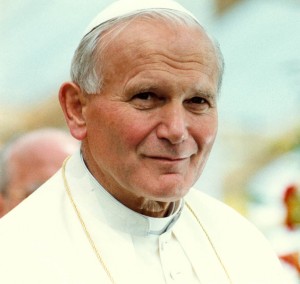Wise Words on Wednesday: Sum of our weaknesses

“We are not the sum of our weaknesses and failures; we are the sum of the Father’s love for us and our real capacity to become the image of his son”
– JP2
"We are travellers…not yet in our native land" – St. Augustine

“We are not the sum of our weaknesses and failures; we are the sum of the Father’s love for us and our real capacity to become the image of his son”
– JP2
Sorry to thread jack….
Hi. Saw your comment on the liturgies on devin’s blog. I had done a long response with the history of the liturgies that got censored so no point in responding there.
I’d agree the liturgy from about 150 on is clearly Catholic. And most of the elements that are in dispute between Catholics and Protestants you can find references going back even further. So I’ll grant without any hesitation that early liturgies were Catholic.
What I won’t grant, was the original claim that the liturgy as it exist today (Mass of Paul VI) is the liturgy of the apostles.
I was responding with 2 things:
a) A history of the liturgy showing that the liturgy through its 2000 year history has major breaks, including idealogical breaks as it develops to 1962.
b) The early liturgies, those prior to about 5th century, were clearly being constructed not being propagated as taught by the apostles.
I’m not going to reconstruct the whole comment but that is the gist of it. I’ve never disputed that by the late 2nd century Catholicism in its essentials exists and is one of the dominant forms of Christianity.
“What I won’t grant, was the original claim that the liturgy as it exist today (Mass of Paul VI) is the liturgy of the apostles.”
Fair enough. I don’t think anyone familiar with liturgical history would try and assert it is. You’re born, you pay taxes, you die and liturgy changes. These are facts of life.
Your other two points you make I’m not hugely sure about…
When I look at the early liturgies and the liturgies in use today I see remarkable continuity. There’s been development and embellishment, sure, but there’s still continuity.
We have no real way of knowing the precise words and gestures taught by the apostles when celebrating the liturgy, but the patristic evidence of the early centuries does point towards a common liturgical “shape”. This would suggest that those early liturgies were not entirely devoid of apostolicity.
Out of interest, what documents do you have in mind when talking about the liturgy prior to AD 150? The Didache?
Nope that (the liturgy was apostolic) was the point of dispute.
Lets start with a few things we have from early Christianity.
— We have angel amulets which appear to be Jewish/Christian or Christian and references in Colossians to sects of angel worshippers… where is that in the liturgy of today?
— We know at least two early sects practiced symbolic baptisms. 1Cor 15:29 or Macrionic baptism for the dead. Those are not part of Catholic rites.
— All sorts of variant theologies exist in these rites. For example adoptionism in the Mozarabic Rite. The move from adoptionism to trinitarianism is a big shift in regardless of which direction you think happened first.
Certainly I’ll agree that there is basically nothing like a Christian sect without a Eucharistic celebration or Baptism. These are the central rites of Christianity. But what I don’t see is any uniformity in the early centuries to what these rites mean or how they are practiced.
That is to say that groups that diverged from proto-Catholicism earlier than the 2nd century, seem not to share anything beyond a basic agreement on the liturgical components. The early 2nd century evidence seems to also lack details.
So I’m not seeing any sort of apostolic shape.
Didache. Sethian materials. Descriptions of Marcionic rites. Justin Martyr’s comments. Dosithean materials. Dead Sea Scrolls have liturgical rites that go back even to 1st and 2nd century BCE. etc….
Well just learned blockquote doesn’t work on this blog and doesn’t change font. So….
1) Fair enough. I don’t think anyone familiar with liturgical history would try and assert it is.
2) We have no real way of knowing the precise words and gestures taught by the apostles when celebrating the liturgy, but the patristic evidence of the early centuries does point towards a common liturgical “shape”.
3) Out of interest, what documents do you have in mind when talking about the liturgy prior to AD 150? The Didache?
Should have all been offset.
Your interpretation of those Scripture passages are far from conclusive and the meaning of those passages is still hotly debated even today. However, there are several ways of resolving the “baptism for the dead” without concluding that it was a rite of the Early Church. The same is true of the angel worship in Colossians.
I’m not quite sure why you’re including Essen and Gnostic material if we’re talking about Christian worship, unless you view them as authentically Christian.
This was the best line from last night’s talk